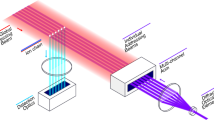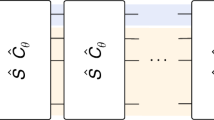Abstract
Most quantum computers use binary encoding to store information in qubits—the quantum analogue of classical bits. Yet, the underlying physical hardware consists of information carriers that are not necessarily binary, but typically exhibit a rich multilevel structure. Operating them as qubits artificially restricts their degrees of freedom to two energy levels1. Meanwhile, a wide range of applications—from quantum chemistry2 to quantum simulation3—would benefit from access to higher-dimensional Hilbert spaces, which qubit-based quantum computers can only emulate4. Here we demonstrate a universal quantum processor using trapped ions that act as qudits with a local Hilbert-space dimension of up to seven. With a performance similar to qubit quantum processors5, this approach enables the native simulation of high-dimensional quantum systems3, as well as more efficient implementation of qubit-based algorithms6,7.
This is a preview of subscription content, access via your institution
Access options
Access Nature and 54 other Nature Portfolio journals
Get Nature+, our best-value online-access subscription
$29.99 / 30 days
cancel any time
Subscribe to this journal
Receive 12 print issues and online access
$209.00 per year
only $17.42 per issue
Buy this article
- Purchase on Springer Link
- Instant access to full article PDF
Prices may be subject to local taxes which are calculated during checkout




Similar content being viewed by others
Data availability
Source data are provided with this paper. The data underlying this work are available via Zenodo at https://doi.org/10.5281/zenodo.6527605.
Code availability
All the codes used for data analysis are available from the corresponding author upon reasonable request.
References
Schindler, P. et al. A quantum information processor with trapped ions. New J. Phys. 15, 123012 (2013).
MacDonell, R. J. et al. Analog quantum simulation of chemical dynamics. Chem. Sci. 12, 9794–9805 (2021).
Rico, E. et al. SO(3) ‘nuclear physics’ with ultracold gases. Ann. Phys. 393, 466–483 (2018).
Bullock, S., O’Leary, D. & Brennen, G. Asymptotically optimal quantum circuits for d-level systems. Phys. Rev. Lett. 94, 230502 (2005).
Bermudez, A. et al. Assessing the progress of trapped-ion processors towards fault-tolerant quantum computation. Phys. Rev. X 7, 041061 (2017).
Lanyon, B. P. et al. Simplifying quantum logic using higher-dimensional Hilbert spaces. Nat. Phys. 5, 134–140 (2008).
Wang, Y., Hu, Z., Sanders, B. C. & Kais, S. Qudits and high-dimensional quantum computing. Front. Phys. 8, 589504 (2020).
Martinez, E. A. et al. Real-time dynamics of lattice gauge theories with a few-qubit quantum computer. Nature 534, 516–519 (2016).
Senko, C. et al. Realization of a quantum integer-spin chain with controllable interactions. Phys. Rev. X 5, 021026 (2015).
Leupold, F. M. et al. Sustained state-independent quantum contextual correlations from a single ion. Phys. Rev. Lett. 120, 180401 (2018).
Malinowski, M. et al. Probing the limits of correlations in an indivisible quantum system. Phys. Rev. A 98, 050102 (2018).
Ahn, J., Weinacht, T. & Bucksbaum, P. Information storage and retrieval through quantum phase. Science 287, 463–465 (2000).
Godfrin, C. et al. Operating quantum states in single magnetic molecules: implementation of Grover’s quantum algorithm. Phys. Rev. Lett. 119, 187702 (2017).
Anderson, B. E., Sosa-Martinez, H., Riofrío, C. A., Deutsch, I. H. & Jessen, P. S. Accurate and robust unitary transformations of a high-dimensional quantum system. Phys. Rev. Lett. 114, 240401 (2015).
Morvan, A. et al. Qutrit randomized benchmarking. Phys. Rev. Lett. 126, 210504 (2021).
Hu, X.-M. et al. Beating the channel capacity limit for superdense coding with entangled ququarts. Sci. Adv. 4, eaat9304 (2018).
Weggemans, J. R. et al. Solving correlation clustering with QAOA and a Rydberg qudit system: a full-stack approach. Quantum 6, 687 (2022).
Kasper, V. et al. Universal quantum computation and quantum error correction with ultracold atomic mixtures. Quantum Sci. Technol. 7, 015008 (2022).
Ringbauer, M. et al. Certification and quantification of multilevel quantum coherence. Phys. Rev. X 8, 041007 (2018).
Kraft, T., Ritz, C., Brunner, N., Huber, M. & Gühne, O. Characterizing genuine multilevel entanglement. Phys. Rev. Lett. 120, 060502 (2018).
Scott, A. J. Multipartite entanglement, quantum-error-correcting codes, and entangling power of quantum evolutions. Phys. Rev. A 69, 052330 (2004).
Shlyakhov, A. R. et al. Quantum metrology with a transmon qutrit. Phys. Rev. A 97, 022115 (2018).
Kristen, M. et al. Amplitude and frequency sensing of microwave fields with a superconducting transmon qudit. npj Quantum Inf. 6, 57 (2020).
Huber, M. & de Vicente, J. I. Structure of multidimensional entanglement in multipartite systems. Phys. Rev. Lett. 110, 030501 (2013).
Campbell, E. T. Enhanced fault-tolerant quantum computing in d-level systems. Phys. Rev. Lett. 113, 230501 (2014).
Campbell, E. T., Anwar, H. & Browne, D. E. Magic-state distillation in all prime dimensions using quantum Reed-Muller codes. Phys. Rev. X 2, 041021 (2012).
Joshi, M. K. et al. Polarization-gradient cooling of 1D and 2D ion Coulomb crystals. New J. Phys. 22, 103013 (2020).
Barenco, A. et al. Elementary gates for quantum computation. Phys. Rev. A 52, 3457–3467 (1995).
Sorensen, A. & Molmer, K. Entanglement and quantum computation with ions in thermal motion. Phys. Rev. A 62, 022311 (2000).
Brennen, G. K., Bullock, S. S. & O’Leary, D. P. Efficient circuits for exact-universal computations with qudits. Quantum Inf. Comput. 6, 436–454 (2005).
Gell-Mann, M. Symmetries of baryons and mesons. Phys. Rev. 125, 1067–1084 (1962).
Gottesman, D. Theory of fault-tolerant quantum computation. Phys. Rev. A 57, 127–137 (1998).
Clark, S. Valence bond solid formalism for d-level one-way quantum computation. J. Phys. A 39, 2701–2721 (2006).
Howard, M. & Vala, J. Qudit versions of the qubit π/8 gate. Phys. Rev. A 86, 022316 (2012).
Magesan, E., Gambetta, J. M. & Emerson, J. Characterizing quantum gates via randomized benchmarking. Phys. Rev. A 85, 042311 (2012).
Fowler, A. G., Mariantoni, M., Martinis, J. M. & Cleland, A. N. Surface codes: towards practical large-scale quantum computation. Phys. Rev. A 86, 032324 (2012).
Low, P. J., White, B. M., Cox, A. A., Day, M. L. & Senko, C. Practical trapped-ion protocols for universal qudit-based quantum computing. Phys. Rev. Res. 2, 033128 (2020).
Pogorelov, I. et al. Compact ion-trap quantum computing demonstrator. PRX Quantum 2, 020343 (2021).
Parrado-Rodríguez, P., Ryan-Anderson, C., Bermudez, A. & Müller, M. Crosstalk suppression for fault-tolerant quantum error correction with trapped ions. Quantum 5, 487 (2021).
Kim, S.: Acousto-Optic Devices for Optical Signal Processing and Quantum Computing. Dissertation, University of Colorado (2008).
Debnath, S. et al. Demonstration of a small programmable quantum computer with atomic qubits. Nature 536, 63–66 (2016).
Häffner, H. et al. Precision measurement and compensation of optical Stark shifts for an ion-trap quantum processor. Phys. Rev. Lett. 90, 143602 (2003).
O’Leary, D. P., Brennen, G. K. & Bullock, S. S. Parallelism for quantum computation with qudits. Phys. Rev. A 74, 032334 (2006).
Ringbauer, M. et al. Characterizing quantum dynamics with initial system-environment correlations. Phys. Rev. Lett. 114, 090402 (2015).
Ferrie, C. & Blume-Kohout, R. Estimating the bias of a noisy coin. AIP Conf. Proc. 1443, 14–21 (2012).
Acknowledgements
We thank M. Huber and J. Wallman for discussions. This project has received funding from the European Union’s Horizon 2020 research and innovation programme under the Marie Skłodowska-Curie grant agreement no. 840450. It reflects only the author’s view; the EU Agency is not responsible for any use that may be made of the information it contains. We also acknowledge support by the Austrian Science Fund (FWF), through the SFB BeyondC (FWF project no. F7109); by the Institut für Quanteninformation GmbH; by the US Army Research Office (ARO) through grant no. W911NF-21-1-0007; by the US Air Force Office of Scientific Research (AFOSR) via IOE grant no. FA9550-19-1-7044 LASCEM; and by the Office of the Director of National Intelligence (ODNI), Intelligence Advanced Research Projects Activity (IARPA), via the US ARO grant no. W911NF-16-1-0070. This project has received funding from the European Union’s Horizon 2020 research and innovation programme under the Marie Skłodowska-Curie grant agreement no. 801110 and the Austrian Federal Ministry of Education, Science and Research (BMBWF).
Author information
Authors and Affiliations
Contributions
M.R. developed the concepts. M.R., M.M., L.P., R.S., P.S. and T.M. performed the experiments. M.R. analyzed the data. T.M. and R.B. supervised the project. All the authors contributed to writing the manuscript.
Corresponding author
Ethics declarations
Competing interests
The authors declare no competing interests.
Peer review
Peer review information
Nature Physics thanks Winfried Hensinger and the other, anonymous, reviewer(s) for their contribution to the peer review of this work.
Additional information
Publisher’s note Springer Nature remains neutral with regard to jurisdictional claims in published maps and institutional affiliations.
Supplementary information
Supplementary Information
Supplementary Discussion 1–8, Figs. 1–11, Tables 1 and 2, and Algorithm 1.
Source data
Source Data Fig. 2
Statistical source data.
Source Data Fig. 3a
Statistical source data.
Source Data Fig. 3b
Statistical source data.
Source Data Fig. 4
Statistical source data.
Rights and permissions
About this article
Cite this article
Ringbauer, M., Meth, M., Postler, L. et al. A universal qudit quantum processor with trapped ions. Nat. Phys. 18, 1053–1057 (2022). https://doi.org/10.1038/s41567-022-01658-0
Received:
Accepted:
Published:
Issue Date:
DOI: https://doi.org/10.1038/s41567-022-01658-0
This article is cited by
-
Navigating the 16-dimensional Hilbert space of a high-spin donor qudit with electric and magnetic fields
Nature Communications (2024)
-
Quantum many-body simulations on digital quantum computers: State-of-the-art and future challenges
Nature Communications (2024)
-
Demonstration of hypergraph-state quantum information processing
Nature Communications (2024)
-
Classification of data with a qudit, a geometric approach
Quantum Machine Intelligence (2024)
-
Advancements in Quantum Computing—Viewpoint: Building Adoption and Competency in Industry
Datenbank-Spektrum (2024)



